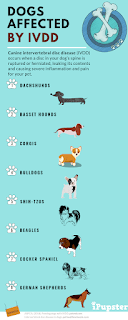The Best Flea Treatments for Cats and Dogs
Intervertebral Disc Disease (IVDD) In Dogs: Symptoms, Causes, & Treatments
Intervertebral disc disease (IVDD) in dogs is a disorder of the spine. This is a neurological condition caused by herniated discs. In humans, this would be similar to a "slipped disc" or "bulging disc."
Generally, IVDD can cause a range of symptoms including back pain and movement issues. Also, it can become progressively worse.
Sadly, certain breeds seem to suffer from the problem more than usual. For example, the Beagle, Dachshund, and Pekinese breeds seem predisposed to it, along with other pups prone to dwarfism — known as chondrodystrophic breeds.
If you see signs that your dog might be suffering from this condition, then you must consult your veterinarian for a proper diagnosis and course of treatment. Here's what you should know about the symptoms, causes, and treatments of intervertebral disc disease in dogs.
Symptoms of intervertebral disc disease (IVDD) in dogsIntervertebral disc disease in dogs can result in a range of symptoms. The symptoms can become progressively worse.
Specifically, some of the most common symptoms include:
Causes of intervertebral disc disease (IVDD) in dogs(Photo Credit: SeventyFourGetty Images)
The cause of the condition is damage to the spinal cord. Specifically, discs between the bones of a dog's spine can become compressed and rupture.
Technically, this process can be acute — which is known as Hansen Type I — or can happen over time due to everyday activity — which is called Hansen Type II. In particular, the following breeds seem to suffer from the Hansen Type 1 version of intervertebral disc disease:
Alternatively, there are some larger breeds predisposed to Hansen Type II of the disease. This is a result of disc degeneration occurring as these dogs age. Specifically, the following breeds seem to often suffer from IVDD:
Treatments for intervertebral disc disease (IVDD) in dogsFirstly, if you think that your dog might be developing the condition, your veterinarian will want to carry out a full physical examination of your dog. Secondly, your vet will ask about your dog's complete medical history. This will include any breed-specific problems.
Next, a number of tests will be used to confirm the condition. For example, baseline blood and urine tests, as well as neurological exams can be used. X-rays are typically taken to assess the extent of narrowing between vertebrae. However, MRIs are now viewed as the gold standard because they allow veterinarians to get a complete picture of the dog's spine. Also, in some cases, a spinal tap will be needed.
Generally, treatment will depend on the severity of the disease. For example, minor cases can benefit from crate rest — to minimize motion — and pain medication. As always, if your vet prescribes your dog any medicine, stick to the correct dose and frequency instructions. Also, these dogs should not be allowed to jump to or from high surfaces. They should avoid dangerous games like frisbee and should be walked using a supportive harness.
However, more severe cases of intervertebral disc disease can require surgery to help decompress any affected discs. In particular, this is done to remove bony vertebra affecting the dog's spinal cord. As such, this is often carried out by a neurosurgeon. Surgery typically costs between $2,000 and $5,000, not including pre- or post-op treatment.
While recovering from surgery, your dog will need to be placed on a reduced exercise regime. Also, physical therapy can often help canines recovering from intervertebral disc disease. Some dogs benefit from the use of a specialized dog wheelchair if they are unable to achieve full mobility even after surgery.
The post Intervertebral Disc Disease (IVDD) in Dogs: Symptoms, Causes, & Treatments appeared first on DogTime.
View comments
Working Dog Centre
Worth AJ, Meij B, Jeffery N. Canine degenerative lumbosacral stenosis: Prevalence, impact and management strategies. Veterinary Medicine: Research and Reports.
Worth AJ, Cave NJ. A veterinary perspective on preventing injuries and other problems that shorten the life of working dogs. Revue Scientifique et Technique-office International des Epizootics 37(1), 161-169, 2018.
Gordon S, Bridges JP, Tomiln SC, Hartman A, Worth AJ. Repeatability of Three-Dimensional Computed Tomographic Volumetric Measurement of Lumbosacral Intervertebral Foramina in German Shepherd Dogs. Veterinary Comparative Orthopedics and Traumatology. 31 (5), 339-343, 2018.
Saunders H, Worth AJ, Bridges JP, Hartman A. Evaluation of the rostral projection of the sacral lamina as a component of degenerative lumbosacral stenosis in German shepherd dogs. Veterinary Surgery 47(5), 654-63, 2018.
Worth AJ, Hartman, A, Bridges JP, Jones BJ, Mayhew IG. Medium-Term Outcome and CT Assessment of Lateral Foraminotomy at the Lumbosacral Junction in Dogs with Degenerative Lumbosacral Stenosis. Veterinary Comparative Orthopedics and Traumatology. 31, 37-43, 2018.
Frame K, Bridges JP, Worth AJ. Effect of a calcaneo-tibial screw on medial and lateral stability of the canine tarsocrural joint ex vivo. Vet Comp Orthop Traumatol 30(5), 331-338, 2017.
Worth AJ, Hartman A, Bridges JP, Jones BR, Mayhew IG. Computed tomographic evaluation of dynamic alteration of the canine lumbosacral intervertebral neurovascular foramina. Veterinary Surgery. Volume 46(2), 255-264, 2017.
Worth AJ, Hartman A, Bridges JP, Jones BR, Mayhew IG. Effect of dorsal laminectomy and dorsal annulectomy with partial lumbosacral discectomy on the volume of the lateral intervertebral neuroforamina in dogs when the lumbosacral junction is extended. Veterinary Surgery. Veterinary Surgery. Volume: 46 Issue: 2 Pages: 265-70, 2017.
When Is Lower Back Pain Serious And What Can Cause It?
There are numerous possible causes of lower back pain. In some cases, it may be due to a serious condition such as degenerative disk disease or cancer. Doctors can diagnose the cause of lower back pain and recommend treatments on the basis of the condition.
According to the American Academy of Orthopedic Surgeons (AAOS), most people's lower back pain is muscular and results from overdoing strenuous activities.
However, if the pain comes from the bones in the spine itself, the person may need prescription medication or surgery to resolve the issue.
This article explores why people may have lower back pain and what symptoms to look for. It also explains some of the more common causes of back pain.
Most cases of lower back pain resolve within a few weeks. However, if the pain continues, the person may have a more serious condition.
Degenerative disk diseaseIf the disks that cushion the vertebrae in a person's back start to break down, the bones may rub together. This can happen due to:
Symptoms of degenerative disk disease can include:
Learn more about degenerative disk disease here.
Herniated diskSometimes, the disks between the vertebrae become squashed, causing them to bulge out between the bones. This is a herniated disk.
A herniated disk can happen anywhere along the spine, but it most commonly affects the lower back. It usually happens as a result of wear and tear over time, though it can also happen due to an injury.
Symptoms of a herniated disk include:
While most people recover without surgery, the AAOS explains that doctors may recommend a microdiscectomy if symptoms do not go away or do not respond to other treatments.
Learn more about herniated disks here.
OsteoporosisA 2018 paper states that many people with osteoporosis experience lower back pain.
Doctors describe osteoporosis as a reduction in bone mass. This means that the person's bones become thinner and weaker. They are also more likely to break.
A person may not experience any symptoms of osteoporosis. This means that there may not be a diagnosis until they experience a broken bone. This can happen due to:
Learn more about osteoporosis here.
Degenerative spondylolisthesisDegenerative spondylolisthesis occurs when one of the vertebrae in the back slips forward. This usually happens when the ligaments connecting the bones weaken and become unstable.
Symptoms of degenerative spondylolisthesis include:
A person with degenerative spondylolisthesis may find relief from symptoms when sitting or bending forward. This is because it helps to open up the space in the spinal canal.
Learn more about spondylolisthesis here.
Ankylosing spondylitisAnkylosing spondylitis is a type of arthritis that often affects the person's sacroiliac joints. The joints connect the spine to the pelvis. This type of arthritis can affect a person's other joints as well.
The most common symptom of ankylosing spondylitis is pain in the:
Learn more about ankylosing spondylitis here.
CancerCancer is not a common cause of lower back pain.
However, the Hospital for Special Surgery points out that doctors may consider cancer as a possible cause if a person has a prior history of cancer or if the back pain occurs alongside a loss of appetite or unexplained weight loss.
Learn more about cancer and lower back pain here.
The American Association of Neurological Surgeons explains that, while lower back pain can be debilitating, for approximately 9 in 10 people it is temporary and surgery is not necessary.
Some common causes of back pain include:
Learn more about the causes of lower back pain here.
Lower back pain varies depending on the cause. The pain may be sharp or dull and it may come and go. Other symptoms may include:
A person with lower back pain should let their doctor know about any symptoms they are experiencing. This will help the doctor to reach an accurate diagnosis.
Learn about sharp lower back pain here.
A person with lower back pain should contact a doctor if the pain lasts longer than two weeks or if it gets worse during this time.
Pain that occurs alongside progressive weakness or numbness may indicate nerve involvement and requires prompt attention.
The AAOS advises people to talk with their doctor if they have an accompanying fever or any unexplained weight loss.
The National Institute of Arthritis and Musculoskeletal and Skin Diseases adds that anyone who experiences back pain after an injury or fall needs to see a doctor.
Loss of bowel or bladder control or problems urinating are also signs that a person needs to see a doctor.
Very occasionally, lower back pain is a sign of a medical emergency. Injuries from accidents, falls, and other traumas can cause back pain, but it may also be a sign of different internal injuries.
A person should seek immediate medical help if they experience any of the following, with or without lower back pain:
Many people experience lower back pain, but it is not usually serious. Occasionally, people with lower back pain have a more serious condition.
Lower back pain may be serious if it results from disk degeneration, a herniated disk, or osteoporosis. Degenerative spondylolisthesis and ankylosing spondylitis are also possible causes that require medical attention. In rare cases, cancer may cause lower back pain.
A person experiencing lower back pain should contact a doctor, particularly if they experience a fall or other injury, if the pain lasts for more than two weeks, or if the pain worsens during this time.



Comments
Post a Comment